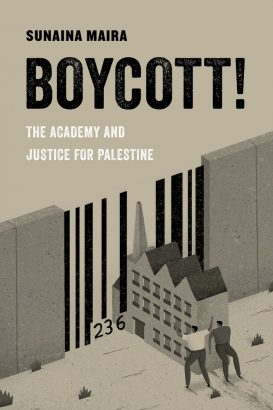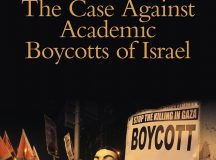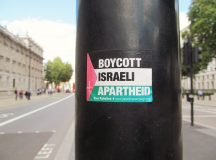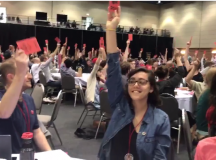Sunaina Maira’s book Boycott! The Academy and Justice for Palestine would not ordinarily be a publication of special note. Such a short, poorly documented book attacking Israel and promoting the Boycott, Sanctions, and Divestment (BDS) movement, would typically come from one of the popular political imprints specialising at least partly in disseminating propaganda — among them CounterPunch, Haymarket, Interlink, Pluto, and Verso. Indeed three of the book’s blurb writers — Angela Davis, Omar Barghouti, and Steven Salaita — write that sort of book themselves. But Boycott! comes to us instead from the University of California Press (UCP), historically one of our more distinguished scholarly publishers. Moreover it is part of a series, American Studies Now, recently founded and edited for UCP by two former presidents of the American Studies Association, Curtis Marez and Lisa Duggan, both themselves leaders of the American Studies Association (ASA) campaign to boycott Israeli universities. Marez and Duggan are praised in the book, but not as a form of toadying to them as series editors. Maira was a leader of the ASA campaign as well. The four, along with additional blurb writer Alex Lubin, speak as one, ideologically.
It is possible for people in political agreement to edit each other’s work critically, to demand high standards of debate and proof from an ally. Where bias could be suspected as part of the review process, they might wish to be especially meticulous. But the character of Maira’s book suggests that none of this happened. Typically a university press review identifies readers sympathetic to the author’s views or methods who are then charged with deciding whether the project is well executed. The alternative of testing a manuscript against hostile readers is a waste of time and money. Whether Davis, Barghouti, Salaita, and Lubin were among the readers I cannot say, but if so they did not successfully apply the standards to be expected in academic publishing. Certainly Marez and Duggan, the series editors with ultimate responsibility, did not. In any case, there is reason now to review the book — in part because it reveals emerging trends in BDS arguments — and ask what such a book says about the state of academic publishing and about the consequences of an increasingly politicised academy.
Indifference to evidence
Midway through the book, Maira devotes several pages to a celebration of the November 2013 annual meeting of the 5,000-member ASA. That is where the movement to boycott Israeli universities first got what remains its most notable endorsement from a faculty association. In the subsequent vote the following month by the ASA’s whole membership the boycott resolution carried the day by a wide margin. Her claim in the book’s introduction that ‘one major academic association after another’ followed by ‘endorsing the boycott’ (1) is a little harder to demonstrate, given that years later the ASA remains the largest such group to do so, whereas the 10,000-member American Historical Association, the 10,000-member American Anthropological Association, and the 25,000-member Modern Language Association have all defeated efforts to endorse an academic boycott. Maira is not alone among BDS apologists in deciding that the best way to handle defeat is to declare victory.
Contempt for conversation
But that is not the only problem with her account of the sequence of ASA events. The binary model that the American Association of University Professors (AAUP) adopted in its classic 1915 Declaration, the statement that defined the group’s principles and mission, proposed that academic freedom entailed both rights and responsibilities, though most of the responsibilities are defined not within the discourse of academic freedom but by institutions and academic disciplines. Foremost among the responsibilities built into the understanding of academic freedom itself is a commitment to a search for truth. But within the academy that search entails a methodology: approaching the truth through dialogue and debate with the existing scholarship. You do not promote your own views without serious engagement with the opposition. Scholarship is a conversation, not simply a polemic. Sunaina Maira’s book, however, is only a polemic.
All she can say about the counter-arguments at the ASA is that they constituted ‘a pitiful case in defence of Israel’ (69). I was not there myself, but I do know several of the boycott opponents who were present, and I have never known them to be ‘pitiful’. More importantly, they report that they focused not on Israel but rather on the damage the resolution would do to academic freedom and to the certainty a boycott would be personal, not institutional. If Maira wants to justify her contempt, she must engage with the substance of the opposition’s arguments. But nowhere does she make any pretense of doing so. I do not deny her right to dismiss opposition arguments. I do fault her for ignoring them. In the academy, contempt should be earned. The best she can do by way of engaging the extensive anti-boycott literature is to say ‘the forces arrayed against the academic boycott and BDS movement also oppose many social justice and progressive movements in the United States, not just Palestine solidarity activism,’ (96) a generalisation that can be applied to the Republican Right, but not to the large number of progressive groups that oppose academic boycotts.
Given that several years have passed since the ASA vote, it is not surprising that substantive reporting and analysis has occurred. A number of such pieces were collected in The Case Against Academic Boycotts of Israel, a book I co-edited with Gabriel Noah Brahm that was published in 2015. The book has been widely reviewed, so Maira’s neglect of it has no impact on its reception, but her failure to engage with one of its original contributions, Sharon Ann Musher’s ‘The Closing of the American Studies Association’s Mind,’ is not merely a disabling oversight. It is a willful disavowal of what it means to be a responsible scholar.
Maira declares that the ASA deliberations included ‘an excess of democratic process and collective decision making,’ (68) whereas Musher’s longer analysis demonstrates that the ASA ‘rejected complicated issues, offering instead, a simplistic good-evil binary’ and showed ‘contempt for a transparent procedure’ (105-6). ‘More than half (ten out of 18) of the voting members of the council, including former presidents Curtis Marez, and the incoming one, Lisa Duggan, had earlier endorsed the US Campaign for the Academic and Cultural Boycott of Israel,’ and a number played leadership roles in the ASA boycott drive (106-7). Musher points out that the ASA conversation was carefully orchestrated to be one-sided; the Town Hall, ‘a supposed forum for an exchange of views was in fact a platform for promoting the boycott resolution’ (110). The event was highlighted by a panel of pro-boycott speakers. Overall, Musher’s 14-page evidence-based essay contrasts with Maira’s unsupported declaration of moral superiority.
In what may be an allusion both to Musher’s essay and to recent legal developments surrounding the ASA votes, Maira is firmly dismissive of ‘the antiboycott lobby’s later allegations that the resolution was sprung on the ASA, supposedly by a secretive group of conspiring academics,’ calling it ‘absurdly false’ (68). Unfortunately for Maira, not long after her book went to press, the discovery phase of a lawsuit against ASA leaders revealed a carefully planned and organised campaign to deceive the organisation’s members. One of the people involved in the campaign — and one of those being sued — is Maira herself, a fact that nowhere makes its way into her book. She participated in a stealth election campaign, partly organised by Jasbir Puar of Rutgers, in which candidates for ASA office privately discussed whether to hide their BDS agenda when composing their candidate statements. One of the emails that Inside Higher Education (IHE) quotes in a December 2017 story includes this passage by Maira: ‘I feel it might be more strategic not to present ourselves as a pro-boycott slate. We need to get on the council and I think our larger goal is support for the resolution, not to test support at this early stage from “outside” the NC [National Council].’ And, indeed, Maira’s candidate statement did not disclose her BDS commitment. Agreeing that Maira’s document disclosure was inadequate, the court had ordered her to supply the additional material by October 2017. That material was the basis of an amended legal action and the IHE story.
This deception is characteristic of Maira’s book. The only claim that is accompanied by supporting information is her statement that the current Palestinian boycott movement was in fact preceded by decades of anti-Jewish and anti-Israel Arab boycott activity. Maira’s opponents would completely agree and have frequently cited that history. Maira in any case does no original research on the matter and does not even synthesise a variety of sources. She simply summarises Mazin Qumsiyeh’s Popular Resistance in Palestine: A History of Hope and Empowerment (2011).
The relentless repetition of anathama
Other than an indifference to evidence and contempt for real conversation, the other most characteristic feature of Maira’s method is its relentless recycling and rearranging of key terms and phrases. As a result, this fairly short book (145 undersized pages plus notes) is weighed down by remarkable repetition. She defines ‘the academic boycott as a social movement that is at the intersection of anti-war, human rights, and global justice organising in the university and beyond, and increasingly embedded in anti-racist, feminist, and queer movements as well’ (2). It ‘addresses the implications of the boycott for anti-racist, anti-colonial, feminist, queer, and academic labor movements’ and generates ‘important struggles over issues of censorship, campus governance, and neoliberal university structures’ (7). It seeks ‘the racist logics of Zionism dismantled’ and does so by way of ‘solidarity via anti-colonial, anti-racist, anti-capitalist, queer, feminist, and indigenous politics’ (17). It faces a ‘vicious Zionist backlash, and the shrill claim that BDS aims to destroy Israel’ (17). In response, Maira endorses a call to ‘”de-Zionise” the academy’ (126) and to ‘take back’ the university from ‘Zionist influence’ (129).
Sometimes the repetitions follow one after another. BDS is ‘a multiracial solidarity movement’ that promotes ‘global cross-racial solidarity’ by seeking out ‘anti-racist allies’ to build ‘transnational coalitions and cross-racial solidarity movements’; it thus forms ‘cross-racial coalitions and alliances with other social justice groups’ (80-81). In doing so, it addresses ‘the racial, class, gender, sexual, and national-colonial politics at the nexus of Zionist settler colonialism and US imperialism’ (85-6), all of which ‘is imbricated with racist, elitist, and homophobic right-wing movements’ (97). Zionism, she adds, ‘articulates with a host of other ills that must be opposed,’ including ‘the class-, gendered, and race-based repression and violence that come with neoliberalism, corporatisation of the academy, White supremacy, Islamophobia, the prison-industrial-complex, heteropatriarchy, the list goes on’ (97). Israel is of course repeatedly condemned as ‘a colonialist, apartheid, militarised garrison state’ (16) with ‘policies of annihilation and racial violence over decades,’ (116) but she considers these accusations so self-evident that, unlike many BDS advocates, she sees no need to provide examples of Israeli bad behavior.
No one, it should go without saying, would be convinced by this sort of gobbledygook unless they wanted to be. But in the contemporary university that is precisely the problem. There is an audience ready and waiting to be hailed by politically correct but cant. Even so, Maira struggles to find a vocabulary to define the relationships both among the BDS movement allies she lists and between the reactionary forces she claims fuel the anti-BDS agenda. Predictably, she begins with crediting intersections, coalitions, and alliances, but soon resorts to embedding, entanglement, and imbrication to demonise the opposition. No effort is made to explore the varied implications these terms have or to differentiate between them.
Mangling the meaning of academic freedom
Along the way, Maira makes several additional claims that could do real damage. Chief among these, I would argue, is a cluster of misdirections about the nature of academic freedom. That begins with an error of omission and misdirection when she characterises the ‘backlash’ against the ASA boycott vote as collusion between powerful pro-Israeli forces and neoliberal university administrators focused on defending Israel. In fact university administrators almost all highlighted only the general principle that boycotts of colleges and universities anywhere undermine the free exchange of people and ideas that define academic freedom and are fundamental to higher education everywhere.
She eventually repeats the confused argument advanced by Omar Barghouti and others that treating academic freedom as a core university value privileges ‘academic freedom as above all other freedoms’ (114). Once again, that is unwarranted hyperbole. Academic freedom does not, for example, trump the rights addressed in the US Constitution; it is a separate value articulated and sustained for the academic community. Maira piously tells us that ‘academic freedom cannot trump other rights to freedom’ (115), but then it doesn’t. No one suggests it should. There is no such hierarchy. Academic freedom does not trump the rights to freedom of speech and religion or the right to trial by jury. A violation of academic freedom does not take precedence over rape, murder, theft or other civil crimes where conviction entails imprisonment. On campus the other rights the AAUP enumerates, like the right to due process, have the same status as academic freedom; they are not subservient rights.
Realising that they have failed to displace academic freedom, BDS advocates have decided to adopt a strategy of discrediting it, of suggesting that academic freedom has actually corrupted the campus by trivialising the other moral and legal values that govern social life. By trying to convince students and faculty that academic freedom is a destructive force, this political tactic undermines the principles that have guided higher education for over a century. That is a high cost for all of us to pay.
Maira deplores ‘the degradations of academic freedom experienced by Palestinian scholars and students’ (60) here and in Palestine. But there is no such pattern in the Western democracies, where the purported ‘lockdown on open discussion of Palestine, Israel, and Zionism in the US academy’ (10) and elsewhere is belied not only by her Berkeley book but by the virtual hegemony of pro-Palestinian thought in many British, Canadian, and US departments. As I argue in ‘Academic Freedom in Palestinian Universities,’ a 2016 Telos essay, the serious ‘lockdown’ on free discussion is the one Palestinian paramilitary groups impose on West Bank institutions.
Her more serious claim is that there ‘is a racialised differential in access to academic freedom’ given that ‘scholars based in the global North are privileged’ (76). The point is, however, that such a differential, which is partly racial but also ethnic, national, and geographic exists in education, employment, health care, housing, social services, and other domains and is a consequence of all these political forces. No specific mechanism exists to differentiate academic freedom by race. Meanwhile, the increasing racial diversity of the US population and in US higher education has made the claim for a ‘racialised differential in access to academic freedom’ somewhat less powerful. There is work to do, but advocacy for the Palestinian cause in North American higher education has no meaningful relation to the overall problem. None of these qualifications, however, affects the fundamental fact that race is the site of America’s deepest and longest running social and historical trauma. But trying to weaponise race in the service of a BDS campaign is certainly misguided and arguably immoral. Nothing good will come of that effort.
The weakness of such arguments lead her to compensate by repeatedly claiming that the BDS movement ‘expands academic freedom — rather than diminishing it, as anti-BDS critics have claimed’ (55). It does so, she says ‘for the oppressed population,’ (62) but she can present no evidence for such an effect, either in the West or in Palestine. Indeed the anti-normalisation campaign that BDS promotes, justifies and encourages shutting down all interaction with Israelis and their supporters. It is difficult to see how this ‘supports and enlarges academic freedom’ (116). Her more revealing claim is the one asserting ‘the dangerous use of academic freedom as a smokescreen for larger struggles over other kinds of freedoms’ (114).
We need to talk about BDS academic publishing
The full list of unsupported claims in the book would be very long. High on my list would be her fantasy assertion that advocacy for Palestine is at the center of the academy’s widespread exploitation of contingent labor (120-21), a pattern that has evolved over two generations, but it is time to return to the general concerns I raised at the outset. Berkeley is one of several university presses, including Duke and Minnesota, that have built lists hostile to Israel and now have a warranted reputation as a place receptive only to anti-Zionist manuscripts that tackle the Israeli-Palestinian conflict. Indeed there are academic presses where a surprising number of professional staff members have publicly supported the BDS movement. Duke is one such venue. At least those staff members have been honest about where they stand, giving fair warning that their personal political beliefs may colour their attitude toward manuscripts submitted. A number of presses with lists in Jewish studies or Israel studies, on the other hand, concentrate their acquisitions in historical scholarship, avoiding more politically charged contemporary topics. But that leaves the polemical terrain to Israel’s critics, which fails to promote more informed debate.
Maira’s and other thinly documented university press books make it starkly clear that the peer review process in a number of subject areas has broken down. That undermines the overall reliability of academic publishing. If Boycott! was substantially improved as a consequence of peer review, it is hard to imagine what the original manuscript could have looked like. She does not engage seriously with a single full-length essay or book critical of the boycott movement or supportive of Israel’s right to exist as a Jewish state. Except for an op-ed, I cannot find a single such work even cited. The entire peace movement receives only dismissive asides, as in her references to ‘tactical resorts to the language of tolerance, peace, dialogue, and coexistence’ (107) and to ‘interfaith tolerance as the solution to a religious conflict, which elides Zionism and anti-Palestinian racism’ (116-17).
Given that Middle East Studies and other academic fields have turned into armed camps, it is not enough to say that a properly executed peer review and editorial process would have prevented a book like Maira’s from being published by a major university press. Some faculty already recognise that peer reviewing of job candidates and candidates for tenure and promotion is often flawed for similar reasons, but an assumption that university press reviews are conducted responsibly may still be widespread. Maira insists that Zionist policing of debate has put academic freedom in crisis, but the evidence here suggests instead that existing mechanisms for imposing standards are inadequate, not excessive. While I do not have a clear solution to the problem to offer, a case can be made that the politicisation of scholarship requires better mechanisms for quality control. At the very least, the heightened risks to objectivity entailed need to be highlighted, rather than ignored. One might call for a general statement on the issues to be formulated with faculty assistance and endorsed by academic publishers.
On the UCP website Curtis Marez points out that books in the series ‘are written in an accessible style that will make them useful in classrooms,’ a standard hope, but one that is worrisome in this context. The Berkeley imprimatur is more likely to encourage course adoption than publication by an officially politicised press. To say the least, significant damage would be done if Boycott! were taught as a recommended model for how scholarly debate about Israel and the BDS movement should be conducted.




































